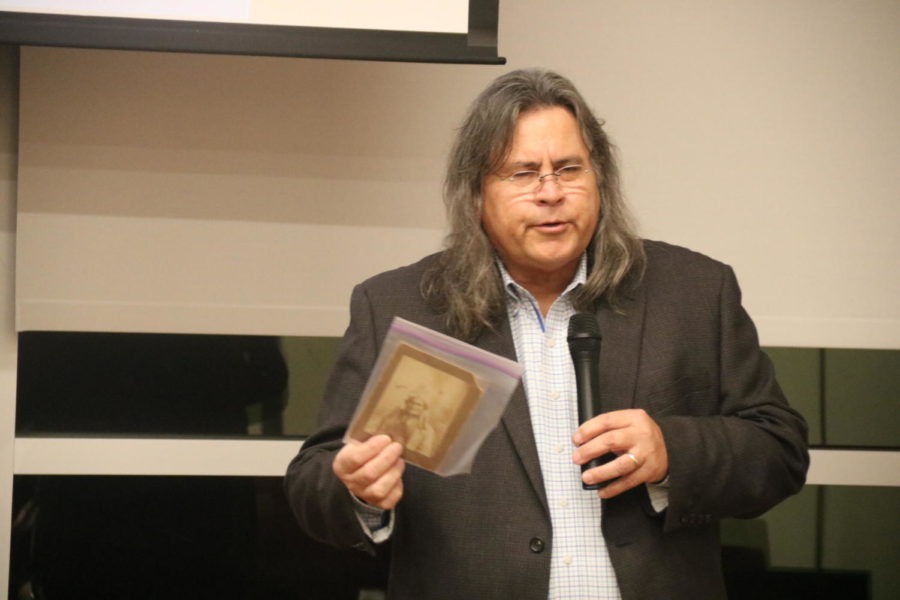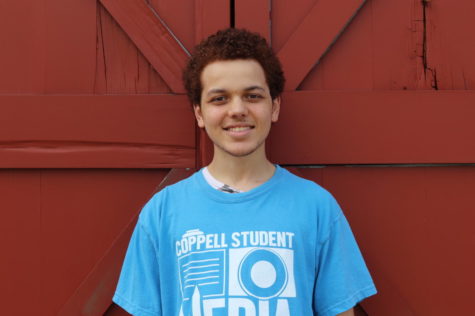Tahmahkera shares stories about Comanche values, Chief Quanah Parker
Lance Tahmahkera speaks about the lives of members of the Comanche tribe from over a century ago in a set of old photos that he has preserved on Thursday. Tahmahkera travels around the country telling the stories of his tribe to keep people aware of his tribes lives and their legends.
November 11, 2019
Chief Quanah Parker was a warrior who lead the Comanche tribe. He made history preserving his Comanche values by wearing braids and leading battles. In addition, he simultaneously had connections with American leaders and gave speeches in large cities.
Lance Tahmahkera is a great-great grandson of Chief Quanah Parker.
On Thursday at the Cozby Library and Commons he spoke about the Comanche way of life and other tribal legends.
“It’s important that our culture [does] not get lost. So many other Comanches do other things, [there are] artists and singers, but for me, storytelling is a way to keep our culture alive,” Tahmahkera said.
Tahmahkera began the discussion by describing that there are 573 federally recognized tribes in the United States while holding a short bow. The bow was made of wood with red feathers detailed at the top.
Hundreds of years ago, Comanches would fire these bows off of horses. Tahmahkera explains that the Comanches lived in a multitude of states, one of them being Texas.
While passing out photos to the audience of Comanche women and children, he acknowledged a Comanche victory at Fort Parker Limestone County. Around 250 Comanches successfully raided the fort.
“I’m impressed with how powerful the Comanche tribe was. I’m fascinated to learn about a winning culture,” attende Terry Danby said, who has been to Comanche County and has a passion for Texas history.
Tahmahkera told some of the tribal legends he heard as a child. When he was young, he didn’t go to school and storytelling was a way for him to learn.
One of these is the story of the buffalo.
The buffalo was created as the strongest animal and was the caretaker of all. Eventually, the buffalo thought that he was better than all of the other animals and pushed them all away. This is what gave the buffalo his hump, to keep his head stooped down low.
The moral of this story is to be humble.
“It’s important that families talk together and share their history and share stories. Any culture is going to get lost unless stories are passed down,” attende Jennifer Murphy said.
Other tribal stories told were about how eagles and bats came to be on earth and the values of pride or kindness.
Nevertheless, the government knew that if it got rid of the buffalo, they could get rid of the Comanches. The Comanches ended up accepting the Medicine Lodge Treaty, a surrender. This deal would also give the Comanches a better life and promised them clothes, education and a hospital. The deal was never ratified.
It would be the last time treaties were discussed between the Comanches and the government. After this, laws were simply made to impact the tribe with no communication or agreement.
Tahmahkera describes his great-great grandfather Quanah Parker’s leadership and life. As soon as Parker learned to write he became more respected by the tribe and American leaders. Parker knew that for the Comanche tribe to survive, they needed to adapt. He learned English, became a judge, supported education and started a Native American church.
“Quanah Parker is a very respectable and honorable human being. [This event] helps people to learn about other people and their history,” Danby said.
However, Parker took his second oldest daughter and raised her solely as a Comanche. She did not speak English. Parker knew that this needed to be done in order to preserve the Comanche culture.
Tahmahkera recalls visiting this second oldest daughter of Parker when she is much older. Her house had no electricity and to get water, it would have to be pumped from the front yard. She only spoke Comanche.
Tahmahkera then describes Chief Quanah Parker’s relationship with Teddy Roosevelt, who visited Parker at his plantation. In a presentation, Tahmahkera displays a photo featuring Parker and Roosevelt together.
Furthermore, Tahmahkera explains that one of the most important Comanche values is having pride in familial pride.
Tahmahkera then tells the story of the Comanche Code Talkers. When Comanches were recruited to war in 1940, one of their men was too small to be accepted. The other Comanches wouldn’t go into the army if the smaller man didn’t get to come.
After much Comanche perseverance, they finally all participated in the war. This exemplifies the Comanche value of family sticking together.
As the discussion came to a close, audience members asked Tahmahkera questions about his great-great grandfather’s life while some looked at the heirlooms including feathers, photos and books.
The people in the audience are now enlightened with the details of Comanche culture and the inspiring story of Chief Quanah Parker.











